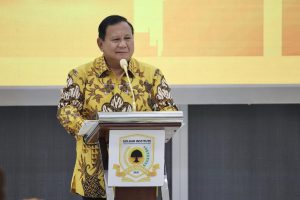Indonesia’s progress on major defense acquisitions under Minister of Defense and presidential candidate Prabowo Subianto has continued apace in recent weeks. A long-gestating deal for Indonesia to buy 24 F-15 fighter jets moved one step closer to completion in August, as Prabowo flew to the United States and inked a Memorandum of Understanding with Boeing.
The deal, which still needs to clear some regulatory hurdles, would be worth almost $14 billion. On the same trip, Prabowo also paid a visit to Lockheed Martin where an agreement for Indonesia to acquire twenty-four Black Hawk helicopters was signed.
Also in August, Indonesian state-owned shipbuilder PT PAL held an official keel-laying ceremony for the Merah Putih frigate project. Merah Putih refers to the colors of the Indonesian flag and has very deliberate nationalist overtones. The project involves the construction of two frigates based on the Arrowhead 140 design to be built by PT PAL in its Surabaya shipyard under license from the UK’s Babcock.
They will be the most advanced surface combatants in the Indonesian Navy upon completion, and represent an ambitious step forward by PT PAL in terms of indigenous production capabilities (of course, we will have to wait for a few years until the project is further along to see how advanced these capabilities actually are). Indonesia also finalized a $300 million deal to buy 12 ANKA drones from Turkey. Delivery is expected in late 2025.
These are new additions to Indonesia’s ongoing air and naval upgrades, which include another major deal to purchase up to 42 Rafale fighter jets from France’s Dassault for $8 billion. Five new C-130J Super Hercules from Lockheed Martin are currently being delivered, and two Atlas A400Ms from Airbus have been ordered.
Local shipyards are turning out fast attack craft and offshore patrol vehicles, while PT PAL has stepped up production of amphibious transport ships and recently co-produced a pair of SIGMA 10514 frigates with Dutch shipbuilder Damen. The Ministry of Defense recently signed a contract with France’s Thales for long-range military radar, a deal that is likely to include some technology transfer and upskilling of Indonesian counterparts.
Clearly, the Indonesian military is looking to modernize and increase its capabilities and these efforts have accelerated during Prabowo’s term as defense minister. One of the questions raised by the pace and scale of these acquisitions is where Indonesia can afford it. Another question is whether there is some broader strategic logic driving this, and if so, what is it?
The answer to the first question is, in my opinion, yes, Indonesia can afford to increase its defense spending. Every time a new deal is announced, a big headline number is splashed around in the media. The Rafales and F-15s alone will cost an estimated $22 billion. Given Indonesia’s history with debt and financial crises, there is often a knee-jerk reaction to such big financial outlays. The state has already been spending heavily on other high-profile and controversial projects such as the new capital city and the Jakarta Bandung high-speed rail, so tens of billions of dollars in public money going toward military equipment could be seen as excessive.
In reality, Indonesia spends less than 1 percent of GDP on defense. By comparison, Singapore – a much smaller country – typically spends around 3 percent of GDP on defense. Moreover, Indonesia’s fiscal position is not as precarious as some people seem to think. True, public spending has increased considerably under Jokowi but revenue from tax receipts has also been growing and Indonesia’s debt-to-GDP ratio remains manageable. We should also remember that large expenditures are paid back over many years, so it is not like the Ministry of Finance has to come up with $22 billion in cash tomorrow.
The more important question is not whether Indonesia can afford this military equipment, it’s whether they are getting good value for it. As I wrote in a previous post, Indonesia approaches military modernization in a very transactional way. It’s actually written into law: major defense systems should be produced domestically, and when that is not possible purchases from foreign parties should include technology transfers and upskilling.
Most of the deals mentioned above involve some form of co-production or knowledge sharing intended to transfer skills and capabilities to Indonesian firms like PT PAL. Whether this actually happens is another question, but that is at least the logic that drives these big acquisitions. It is also why we should be careful about framing Indonesia’s military modernization in broad geopolitical terms, as some kind of arms race or hedging strategy specifically intended to balance or deter China.
The truth is actually much simpler than that. Indonesia likely wants to increase its military capabilities during a time of sharpening geopolitical tensions. But the reason they are turning to defense firms in Turkey, France, the UK, and (increasingly) the United States is not necessarily part of a grand hedging strategy, but because Thales, Airbus, Lockheed, Babcock and Turkish Aerospace are willing to share production, sell licenses, train Indonesian mechanics and engineers and give Indonesia what it really wants: indigenous production capabilities.

































